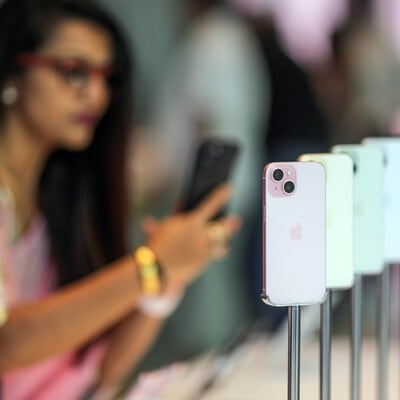By Andy Mukherjee
In the past year, more than 600 Indian banks moved $2.5 trillion, or 80 per cent of gross domestic product, between customer accounts. All these transactions originated on smartphones, with people paying a mobile number, or settling bills by scanning QR codes.
It’s surprising, therefore, that India, one of the biggest global successes of instant money transfers, would want to punish its lenders for being a tad too successful at promoting technology. “Banks shall assign an additional 5 per cent run-off factor for retail deposits which are enabled with internet and mobile banking,” the monetary authority said in a circular last week on liquidity standards.
The Reserve Bank of India’s new norms, which will come into force April 1, aim to ensure that the country’s lending institutions have enough liquid assets, such as cash and government securities, at all times to meet outflows. When estimating their cash outgoings over a 30-day period, banks currently assume that at most 5 per cent of stable retail deposits — and a similar quantum of funds parked with them by small businesses — will leave. This requirement is being raised to 10 per cent by increasing the so-called run-off factor.
The more flighty a deposit, the higher the requirement to hold high-quality assets. That leaves fewer resources to give out to borrowers. CRISIL, an affiliate of S&P Global Inc., says credit growth may moderate from its expectation of 14 per cent for the current fiscal year as banks rebuild their liquidity buffers. A bigger slice of low-risk, low-return assets on their balance sheets could also crimp banks’ net interest margins, given that deposit costs are also going up. With bad loans starting to rise, it might be a triple whammy.
So why go after accounts that can be operated with smartphones? Blame the second-biggest US banking failure in history. In March last year, swirling questions about Silicon Valley Bank’s investment portfolio spooked depositors so badly that they suddenly asked for $42 billion of their money back in a single day. The next morning, the Santa Clara, California-based bank was shuttered. Federal regulators had to step in and contain panic by guaranteeing all deposits, even those above the $250,000 legal limit.
Digital technology enabled SVB customers to try to move $500,000 a second. If they had to queue up, like in a traditional bank run, both the bank management and regulators would have had more time to respond. To ensure that such situations don’t arise in India, where less than half of the deposit value is insured, the RBI is acting proactively. It’s asking lenders to be more realistic about their liquidity needs — in case customers’ first response to a rumor about a bank’s health is to whip out their phones.
A large and growing section of India’s depositors has to be considered a flight risk. Out of 820 million active internet users last year, 370 million used the web for digital banking. Among people who can afford smartphones, it’s mainly the older demographic that still likes to visit branches or ATMs. Although the gender gap is narrowing, when it comes to paying for things online, women are more likely to pay cash on delivery than men. For lenders scurrying to meet the RBI’s new standards, that’s a good thing.
“My mother’s 10,000-rupee deposit is more valuable for the bank than my 10,000-rupee deposit,” says Krishna Hegde, a Bengaluru-based fintech professional who helps rich people and institutions invest in crypto. In singling out mobile-linked accounts, however, the RBI may have missed another source of vulnerability: brokered deposits, where a middleman influences savers’ choice of where to place their funds. Three years ago, Alphabet Inc. began to dip into the popularity of its local-payments app to route deposits to an Indian lender. Funds sourced by a third party are likely to be less durable, says Hegde, who was part of the team that built an interface to enable lenders to accept deposits via Google Pay.
)
Brokered deposits are tomorrow’s problem. Even the RBI’s current proposal will leave banks uncomfortably stretched. The median liquidity coverage — a measure of how easily they can meet withdrawals — may fall to 117 per cent, from 136 per cent in March, for the 31 banks analysed by CRISIL. This deterioration comes at a time when credit growth in the economy has been running ahead of deposits for a long time, and by a large margin. The gap, as high as 6 percentage points in the fiscal year that ended in March 2023, halved in the following 12 months. It is widening again.
A new loan should, in theory, create a new deposit somewhere in the banking system. Yet, the RBI is worried that household savings that used to predominantly flow to banks are now increasingly leaning toward mutual funds, pension companies and insurance pools. Parched for deposits, banks have been liquidating their excess holdings of government securities. The more they pare down liquid assets, the less cushion they will have to deal with an SVB-type shock.
The intense competition for deposits is partly cyclical. Interest rates, kept elevated by the central bank because of stubborn inflation, have to be passed through to savers, lest they up and leave. But the quest for liquidity was exacerbated after Housing Development Finance Corp., an underwriter of homes for millions of Indians, decided to combine with HDFC Bank Ltd. The mortgage financier came to the merger with a loan book, even as the deposits against its advances to homeowners and builders were spread across the banking system. After swallowing its parent on July 1, 2023, the bank’s loans surged to as high as 114 per cent of deposits, from 88 per cent, according to Bloomberg data.
First Published: Aug 01 2024 | 7:58 AM IST
